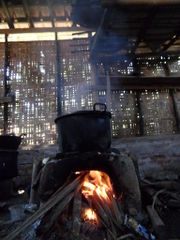Knowledge fuels change - Support energypedia!
For over 10 years, energypedia has been connecting energy experts around the world — helping them share knowledge, learn from each other, and accelerate the global energy transition.
Today, we ask for your support to keep this platform free and accessible to all.
Even a small contribution makes a big difference! If just 10–20% of our 60,000+ monthly visitors donated the equivalent of a cup of coffee — €5 — Energypedia would be fully funded for a whole year.
Is the knowledge you’ve gained through Energypedia this year worth €5 or more?
Your donation keeps the platform running, helps us create new knowledge products, and contributes directly to achieving SDG 7.
Thank you for your support, your donation, big or small, truly matters!
Cooking Around the World
Overview
Around the world humans prepare many different types of food in many different ways. 95% of staple foods, need to be cooked before they can be eaten.[1] There is even the theory from Richard Wrangham which says that the human as species can just survive with cooking.[2] Cooking can be a hobby, cultivated with passion in a modern kitchen. Unfortunately this is generally true just for a privileged minority, with access to modern cooking fuels and appliances. For the majority cooking is an often dangerous chore on open fire in small huts.
Cooking Inside
Over 3 billion people eat food prepared on open fires and traditional cookstoves.[3] Mostly inside, because for very practical reasons people usually do not cook outside[4]: During the dry seasons it’s too hot outside. During the rainy season it is too wet. As soon as it gets windy, dust and dirt blow into the food. Outdoors animals could steal the food. On an open fire even a slight breeze blows the heat away from the cooking pot and cooking takes longer and needs much more fuel. In some areas the fire must be inside the house for indoor heating or lighting purposes.
There are also deep-seated social reasons why people don’t cook outdoors: What people eat reflects their social status and people can be very sensitive about their neighbors’ views of their status. Sometimes people may not want their neighbors to know what they are cooking and eating as it may be seen as being inferior or to seek the privacy of their home. In some cultures fire can be considered sacred and must be at the heart of the home.
Energy Needs
Cooking requires energy, that means that more than half of the population needs dung, wood, crop waste or coal for their most basic energy needs. A high percentage of women and girls collect firewood every day, precluding them from work and education and exposing them to security risks. Nearly half the world’s wood supply is used as fuel.[5] In many cases the demand for biomass fuels exceeds sustainable supply by far. This leads to massive deforestation, land degradation and desertification. Open fires and traditional stoves tend to be highly inefficient and lose a large percentage of the fuel energy as so-called products of incomplete combustion which is in the end responsible for indoor air pollution (IAP).[6]
Further Information
- All about cooking on energypedia: Cooking Energy Compendium
- Energy for Cooking in Developing Countries - IEA
- Clean Cooking in the Markets of Maputo
References
- ↑ Warwick, Hugh and Doig, Alison: smoke – the killer in the kitchen. Indoor Air Pollution in Developing Countries. London: ITDG Publishing, First published in 2004. http://practicalaction.org/docs/smoke/itdg%20smoke%20report.pdf
- ↑ Wrangham, Richard: Catching Fire: How Cooking Made Us Human, 1. Published 2009, ISBN-10: 0465013627
- ↑ WHO: http://www.who.int/mediacentre/factsheets/fs292/en/
- ↑ Practical Action: http://practicalaction.org/faq-2#Why%20use%20fires%20inside%20the%20home
- ↑ Solar box cookers: http://www.journeytoforever.org/sc.html
- ↑ WHO, GLOBAL HEALTH RISKS, Mortality and burden of disease attributable to selected major risks. http://www.who.int/healthinfo/global_burden_disease/GlobalHealthRisks_report_full.pdf





















